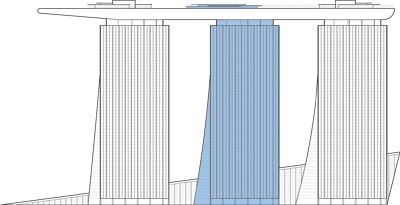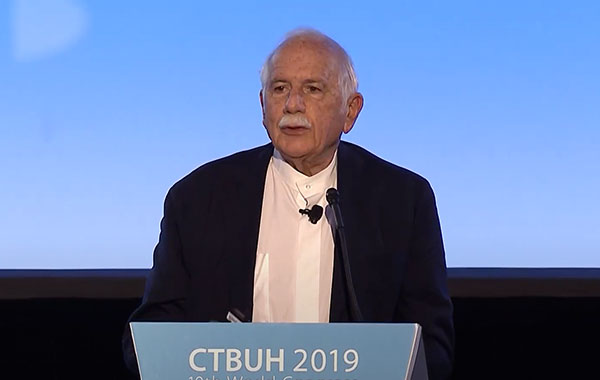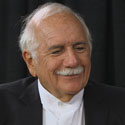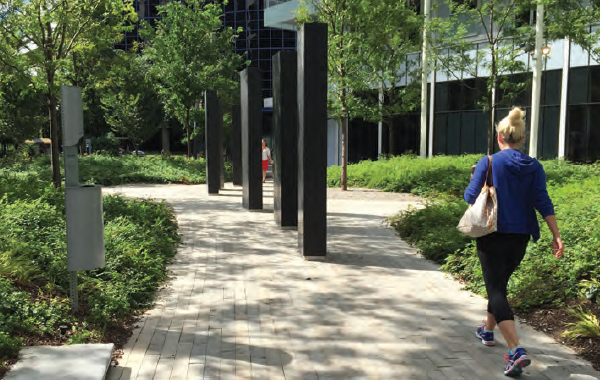Filter by
You must be a CTBUH Member to view this resource.

Marina Bay Sands Hotel Tower 2
Marina Bay Sands Integrated Resort - Hotel Tower 2
Building
Completed
2010
Hotel
Concrete-Steel Composite
202.8 m / 665 ft
57
3
30
8 m/s
You must be a CTBUH Member to view this resource.
You must be a CTBUH Member to view this resource.
Proposed
Construction Start
Completed
Usually involved in the front end design, with a "typical" condition being that of a leadership role through either Schematic Design or Design Development, and then a monitoring role through the CD and CA phases.
Usually takes on the balance of the architectural effort not executed by the "Design Architect," typically responsible for the construction documents, conforming to local codes, etc. May often be referred to as "Executive," "Associate," or "Local" Architect, however, for consistency CTBUH uses the term "Architect of Record" exclusively.
The Design Engineer is usually involved in the front end design, typically taking the leadership role in the Schematic Design and Design Development, and then a monitoring role through the CD and CA phases.
The Design Engineer is usually involved in the front end design, typically taking the leadership role in the Schematic Design and Design Development, and then a monitoring role through the CD and CA phases.
The Engineer of Record takes the balance of the engineering effort not executed by the “Design Engineer,” typically responsible for construction documents, conforming to local codes, etc.
Other Consultant refers to other organizations which provided significant consultation services for a building project (e.g. wind consultants, environmental consultants, fire and life safety consultants, etc).
These are firms that consult on the design of a building's façade. May often be referred to as "Cladding," "Envelope," "Exterior Wall," or "Curtain Wall" Consultant, however, for consistency CTBUH uses the term "Façade Consultant" exclusively.
Material Supplier refers to organizations which supplied significant systems/materials for a building project (e.g. elevator suppliers, facade suppliers, etc).
You must be a CTBUH Member to view this resource.
Usually involved in the front end design, with a "typical" condition being that of a leadership role through either Schematic Design or Design Development, and then a monitoring role through the CD and CA phases.
Usually takes on the balance of the architectural effort not executed by the "Design Architect," typically responsible for the construction documents, conforming to local codes, etc. May often be referred to as "Executive," "Associate," or "Local" Architect, however, for consistency CTBUH uses the term "Architect of Record" exclusively.
The Design Engineer is usually involved in the front end design, typically taking the leadership role in the Schematic Design and Design Development, and then a monitoring role through the CD and CA phases.
The Peer Review Engineer traditionally comments on the information produced by another party, and to render second opinions, but not to initiate what the design looks like from the start.
The Design Engineer is usually involved in the front end design, typically taking the leadership role in the Schematic Design and Design Development, and then a monitoring role through the CD and CA phases.
The Engineer of Record takes the balance of the engineering effort not executed by the “Design Engineer,” typically responsible for construction documents, conforming to local codes, etc.
The CTBUH lists a project manager when a specific firm has been commissioned to oversee this aspect of a tall building’s design/construction. When the project management efforts are handled by the developer, main contract, or architect, this field will be omitted.
The main contractor is the supervisory contractor of all construction work on a project, management of sub-contractors and vendors, etc. May be referred to as "Construction Manager," however, for consistency CTBUH uses the term "Main Contractor" exclusively.
Other Consultant refers to other organizations which provided significant consultation services for a building project (e.g. wind consultants, environmental consultants, fire and life safety consultants, etc).
These are firms that consult on the design of a building's façade. May often be referred to as "Cladding," "Envelope," "Exterior Wall," or "Curtain Wall" Consultant, however, for consistency CTBUH uses the term "Façade Consultant" exclusively.
Material Supplier refers to organizations which supplied significant systems/materials for a building project (e.g. elevator suppliers, facade suppliers, etc).
12 August 2009 - Event

31 October 2019 | Singapore
Moshe Safdie, Founder at Safdie Architects, speaks at the 2019 CTBUH International Congress in Chicago on 31 October 2019.

30 January 2020
CTBUH Research
The combined brains of the CTBUH editorial and database staff boldly predict what might happen across the global skyscraper industry in 2020. Check out our...
Marina Bay Sands is a high-density, mixed-use integrated resort that brings together a 2,560-room hotel, a SkyPark, convention center, shopping and dining, theaters, museum, and a casino across the water from Singapore’s central business district. The 929,000 sq m (10,000,000 sq ft) urban district anchors the Singapore waterfront, and creates a gateway to Singapore. The design approach for the complex was not as a building project, but as a microcosm of a city—rooted in Singapore’s culture, climate and contemporary life. The aim was to create an urban landscape capable of addressing the issue of megascale.
The project is designed as an urban structure that weaves together the components of a complex program into a dynamic urban crossroads and public meeting place. Inspired by great ancient cities that were ordered around a vital public thoroughfare, Marina Bay Sands is organized around two principal axes that traverse the district and give it a sense of orientation placing emphasis on the pedestrian street as the focus of civic life. Combining indoor and outdoor spaces and providing a platform for a wide array of activities, this vibrant, 21st-century cardo maximus, or grand arcade, also connects to the subway and other transportation. A series of layered gardens provide ample green space throughout the site, extending the tropical garden landscape from Marina City Park towards the Bayfront. The landscape network reinforces urban connections with the resort’s surroundings and every level of the district has green space that is accessible to the public.
The most innovative aspect of Marina Bay Sands, both conceptually and technically, is the 1 hectare (2.5 acre) SkyPark atop the hotel towers. Locating the park and hotel amenities at 200m (656ft) above the sea afforded the architect the ability to keep the majority of the project relatively low in height. The three towers anchor the district and are connected at the top by the SkyPark—an engineering marvel that is longer than the Eiffel Tower is tall and large enough to park four-and-a-half A380 jumbo jets. The 65m (213ft) cantilever of the SkyPark past the third hotel tower forms one of the world’s largest public cantilevers.
The SkyPark accommodates a public observatory, gardens, a 151 meter-long (495 foot-long) swimming pool, restaurants, and jogging paths and offers sweeping panoramic views, a formidable resource in a dense city like Singapore. Shielded from the winds and lavishly planted with hundreds of trees, the SkyPark celebrates the notion of the Garden City that has been the underpinning of Singapore’s urban design strategy.
A post-tensioned box girder was designed to achieve this incredible cantilever. The maximum depth of the box girder is 10m (33ft) at the end support from the hotel tower and generally 3.5m (11ft) deep. The lifting of the SkyPark was one of the many challenges that the project faced that required an innovative approach to the construction methods in order to facilitate one of the highest strand jacking operations ever undertaken.
The hotel towers on which the SkyPark sits has an unusual and spectacular form that creates its distinct silhouette. Each tower is formed by two curved and splayed legs that lean into one another as they rise, ultimately becoming one at the upper levels. At the ground level, the space between each tower is enclosed to create a hotel lobby and atrium, at the upper levels the space is conceived as an “urban window” that allows for views through the project. Major steel trusses form a connection between the separate segments of the building’s legs to provide a frame to transfer sheer between the towers and tie the buildings together to resist lateral forces.

31 October 2019 | Singapore
Moshe Safdie, Founder at Safdie Architects, speaks at the 2019 CTBUH International Congress in Chicago on 31 October 2019.

30 October 2017 | Singapore
Quay Quarter Tower (QQT) will create a stunning new building on the Sydney skyline that sets new benchmarks in office tower design globally and creates...

26 October 2015 | Singapore
Moshe Safdie of Safdie Architects is interviewed by Chris Bentley during the 2015 CTBUH New York Conference at the Grand Hyatt New York. Moshe discusses...

10 October 2011 | Singapore
A construction CEO will share his vivid experience of overcoming challenges in the construction of Raffles City Complex and Marina Bay Sands Hotel in Singapore....

30 January 2020
CTBUH Research
The combined brains of the CTBUH editorial and database staff boldly predict what might happen across the global skyscraper industry in 2020. Check out our...

08 August 2017
Leading Women in Tall Buildings
Recently, there has been a growing and overdue recognition in the architecture discipline that women are under-represented, not just in terms of leadership positions held,...

17 October 2016
James Parakh, City of Toronto Planning Division
This paper is intended to introduce the upcoming CTBUH technical guide titled “The Space Between,” which investigates the importance of publicly accessible spaces surrounding tall...
sumner.jpg)
04 February 2016
Daniel Safarik, CTBUH
A growing number of tall buildings recognized by the CTBUH, through its international awards programs and research, are noteworthy not so much because of their...

22 January 2011
Moshe Safdie, Safdie Architects
Marina Bay Sands is a high-density and mixed-use integrated resort complex which was conceived as a city microcosm rooted in Singapore’s culture, climate, and contemporary...
Subscribe below to receive periodic updates from CTBUH on the latest Tall Building and Urban news and CTBUH initiatives, including our monthly newsletter. Fields with a red asterisk (*) next to them are required.
View our privacy policy